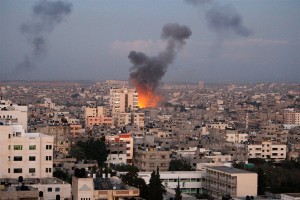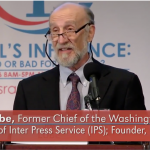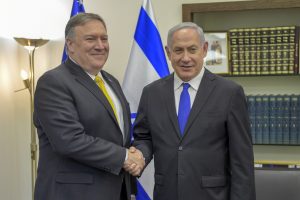 As I’m in Wilson, North Carolina, where I haven’t gotten my hands on any print editions of national newspapers (reading actual newspaper clips is the only reliable way i retain information about current events), I haven’t been able to keep up with the Israel’s latest offensive against Gaza. But I remembered that Ali and I wrote about the trigger for hostilities — Israel’s apparently deliberate breaking of a long-standing cease-fire on Nov 4, 2008 — and how completely it was ignored in U.S. mainstream media coverage of Israel’s Cast Lead Operation four years ago. So that story is reproduced after the jump.
As I’m in Wilson, North Carolina, where I haven’t gotten my hands on any print editions of national newspapers (reading actual newspaper clips is the only reliable way i retain information about current events), I haven’t been able to keep up with the Israel’s latest offensive against Gaza. But I remembered that Ali and I wrote about the trigger for hostilities — Israel’s apparently deliberate breaking of a long-standing cease-fire on Nov 4, 2008 — and how completely it was ignored in U.S. mainstream media coverage of Israel’s Cast Lead Operation four years ago. So that story is reproduced after the jump.
Meanwhile, for more — and much more scholarly background — on the run-up to Cast Lead and hopes at the time for a permanent cease-fire, this International Security article by Jerry Slater is a must read.
Also, Gershon Baskin elaborates on his efforts to negotiate a permanent cease-fire in a column in the New York Times today, calling al-Jabari’s assassination “short-sighted” — an adjective with which Slater might disagree given the Israeli government’s persistent rejectionism from the time Hamas gained control of Gaza.
US-MIDEAST: Media Eyeless in Gaza at Key Moment
Jim Lobe and Ali Gharib
WASHINGTON, Jan 7 2009 (IPS) – Consumed by coverage of the Nov. 4 presidential election, U.S. mainstream media ignored a key Israeli military attack on a Hamas target that some Palestinians claim marked the effective end of the ceasefire between the two sides and set the stage for the current round of bloodletting.
While the major U.S. news wire Associated Press (AP) reported that the attack, in which six members of Hamas’s military wing were killed by Israeli ground forces, threatened the ceasefire, its report was carried by only a handful of small newspapers around the country.
The Nov 4 raid – and the escalation that followed – also went unreported by the major U.S. network and cable television new programmes, according to a search of the Nexis database for all English-language news coverage between Nov. 4 and 7.
But the military action, which was followed up by an aerial attack that killed at least one other Palestinian, appears to have dealt a fatal blow to the Egyptian-mediated ceasefire that had taken effect Jun. 19 and largely held for some four and a half months.
In retaliation for the attack, Hamas launched some 35 Qassam rockets into Israeli territory Nov. 5 which, in turn, provoked Israel to severely tighten its then-17-month-old economic siege of the Palestinian territory.
“While neither side ever completely respected the ceasefire terms, the Israeli raid was far and away the biggest violation,” said Stephen Zunes, an expert on the Palestinian-Israeli conflict at the University of San Francisco.
“It was a huge, huge provocation, and it now appears to me that it was actually intended to get Hamas to break off the ceasefire,” he added.
When Israel launched its current military offensive against Hamas-controlled Gaza Dec. 27, most major U.S. media outlets – and particularly television and newspaper commentators – blamed Hamas for breaking the ceasefire by continuing rocket and mortar attacks on Israeli territory and refusing to extend the ceasefire on its current terms beyond its formal Dec. 19 expiration.
“Israel’s air offensive against the Gaza Strip yesterday should not have been a surprise for anyone who has been following the mounting hostilities in the region,” said the lead editorial in the Washington Post the day after Israel began its massive air assault, “least of all the Hamas movement, which invited the conflict by ending a six-month-old ceasefire and launching scores of rockets and mortar shells at Israel during the last 10 days.”
This explanation of events corresponded to a major Israeli public-relations effort that placed top government officials on U.S. network and cable news programmes. In an appearance on NBC’s widely viewed Sunday morning talk show ‘Meet the Press’, as the military offensive got underway, for example, Israeli Foreign Minister Tzipi Livni, also a candidate for prime minister in the Feb. 10 elections, set forth her government’s basic narrative.
“About a half a year ago, according to the Egyptian Initiative, we decided to enter a kind of a truce and not to attack Gaza Strip,” Livni said. “Hamas violated, on a daily basis, this truce. They targeted Israel, and we didn’t answer.”
But that narrative omitted any mention of the critical Nov. 4 raid, and no Palestinian guest, such as Mustafa Barghouti, an independent Palestinian lawmaker and human rights activist from Ramallah, appeared on the programme to rebut her claim.
In an interview on CNN two days later, on Dec. 31, however, Barghouti charged that Livni’s version of events was “incorrect”. He accused Israel of breaking the truce and pointed directly to the Nov. 4 operation in Gaza as the catalysing incident.
“Two months before (Dec. 19), Israel started attacking Rafah, started attacking Hamas…” he declared, adding that Israel’s failure to lift its commercial embargo against Gaza also violated the Palestinian understanding of the original truce terms.
Indeed, Barghouti’s focus on the Nov. 4 attack as the main cause of the ceasefire breakdown was implicitly supported by a lengthy report released the following day by the Intelligence and Terrorism Information Centre, a private Israeli group. It divided the ceasefire into a “period of relative quiet between June 19 and November 4?, when “Hamas was careful to maintain the ceasefire,” and “the escalation and erosion of the …arrangement” which it dated to “November 4 (when) the IDF (Israel Defense Forces) carried out a military action close to the border security fence on the Gazan side…”
It further noted that Hamas began firing rockets and missile shells “in retaliation” to which Israel responded by closing its border crossings and sharply tightening its siege against Gaza. From that point, the ceasefire that had effectively held for the previous four and a half months was never fully restored.
That version of events was not entirely missing from the U.S. press. Indeed, a New York Times “analysis” published Dec. 19 acknowledged that “(w)hile this (escalation) did not topple the agreement, Israel’s decision in early November to destroy a tunnel Hamas had been digging near the border drove the cycle of violence to a much higher level.”
But the Times itself, like virtually all of the U.S. media, had missed the likely impact of the Nov. 4 attack on the ceasefire’s fate at or even shortly after it took place. In its late edition Nov. 5, the newspaper ran a 422-word article datelined Jerusalem that reported Israel’s military operation and the fact that Hamas had retaliated with mortar fire.
One day later, the Washington Post devoted a similar amount of space to a Reuters report whose headline suggested that the truce had been put at risk by the previous day’s exchanges.
But while the U.S. media, distracted by an historic election at home, largely skipped over the significance of the Nov. 4 Israeli raid, several English-language foreign news organisations did publish articles on the event, suggesting that the raid could very well have doomed the ceasefire.
A story in the British newspaper the Guardian on Nov. 6 said the truce was “in jeopardy” after the strike. Another British paper, the Independent, said on the same day that the ceasefire “was foundering yesterday after Israeli special forces entered the besieged territory and fought Hamas.”
A piece for the Canadian news service Canwest on Nov. 6 said that “the fragile peace [of the ceasefire] was shattered overnight by an Israeli raid in Gaza.” The Age newspaper of Australia also headlined its story on the raid itself as “Ceasefire in danger of collapse.”
AP’s Nov. 5 and 6 stories used similar wording in its stories, but they went largely unpublished in the U.S. where media attention was focused virtually exclusively on the historic election results.
The Nexis search found no reference to the raid in the transcripts of any television public-affairs broadcast during the period, a particularly significant omission given the fact that about 70 percent of U.S. citizens say their main source of international news comes through that medium.
“(T)hat Nov. 4 raid, in very real sense, hardly exists in the mainstream media’s collective memory,” said Fairness and Accuracy In Reporting (FAIR)’s activism director Peter Hart, noting that Israel may have been aware that the election would drown out coverage of its raid.
“It does not take much effort to go back and find it, but reporting contextual information that would undermine Israel’s rationale for these attacks is not exactly the kind of thing the U.S. corporate media do very often. The fact that there are only a handful of exceptions is telling – the dominant narrative in the press is unsurprisingly one that supports the Israeli position.”




